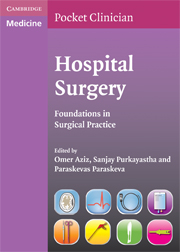Book contents
- Frontmatter
- Contents
- List of contributors
- Foreword by Professor Lord Ara Darzi KBE
- Preface
- Section 1 Perioperative care
- Section 2 Surgical emergencies
- Section 3 Surgical disease
- Hernias
- Dysphagia: gastro-oesophageal reflux disease (GORD)
- Dysphagia: oesophageal neoplasia
- Dysphagia: oesophageal dysmotility syndromes
- Gastric disease: peptic ulcer disease (PUD)
- Gastric disease: gastric neoplasia
- Hepatobiliary disease: jaundice
- Hepatobiliary disease: gallstones and biliary colic
- Hepatobiliary disease: pancreatic cancer
- Hepatobiliary disease: liver tumours
- The spleen
- Inflammatory bowel disease: Crohn's disease
- Inflammatory bowel disease: ulcerative colitis
- Inflammatory bowel disease: infective colitis
- Inflammatory bowel disease: non-infective colitis
- Colorectal disease: colorectal cancer
- Colorectal disease: colonic diverticular disease
- Perianal: haemorrhoids
- Perianal: anorectal abscesses and fistula in ano
- Perianal: pilonidal sinus and hidradenitis suppurativa
- Perianal: anal fissure
- Chronic limb ischaemia
- Abdominal aortic aneurysms
- Diabetic foot
- Carotid disease
- Raynaud's syndrome
- Varicose veins
- General aspects of breast disease
- Benign breast disease
- Breast cancer
- The thyroid gland
- Parathyroid
- Adrenal pathology
- Multiple endocrine neoplasia (MEN)
- Obstructive urological symptoms
- Testicular lumps and swellings
- Haematuria
- Brain tumours
- Hydrocephalus
- Spinal cord injury
- Superficial swellings and skin lesions
- Section 4 Surgical oncology
- Section 5 Practical procedures, investigations and operations
- Section 6 Radiology
- Section 7 Clinical examination
- Appendices
- Index
Dysphagia: oesophageal neoplasia
Published online by Cambridge University Press: 06 July 2010
- Frontmatter
- Contents
- List of contributors
- Foreword by Professor Lord Ara Darzi KBE
- Preface
- Section 1 Perioperative care
- Section 2 Surgical emergencies
- Section 3 Surgical disease
- Hernias
- Dysphagia: gastro-oesophageal reflux disease (GORD)
- Dysphagia: oesophageal neoplasia
- Dysphagia: oesophageal dysmotility syndromes
- Gastric disease: peptic ulcer disease (PUD)
- Gastric disease: gastric neoplasia
- Hepatobiliary disease: jaundice
- Hepatobiliary disease: gallstones and biliary colic
- Hepatobiliary disease: pancreatic cancer
- Hepatobiliary disease: liver tumours
- The spleen
- Inflammatory bowel disease: Crohn's disease
- Inflammatory bowel disease: ulcerative colitis
- Inflammatory bowel disease: infective colitis
- Inflammatory bowel disease: non-infective colitis
- Colorectal disease: colorectal cancer
- Colorectal disease: colonic diverticular disease
- Perianal: haemorrhoids
- Perianal: anorectal abscesses and fistula in ano
- Perianal: pilonidal sinus and hidradenitis suppurativa
- Perianal: anal fissure
- Chronic limb ischaemia
- Abdominal aortic aneurysms
- Diabetic foot
- Carotid disease
- Raynaud's syndrome
- Varicose veins
- General aspects of breast disease
- Benign breast disease
- Breast cancer
- The thyroid gland
- Parathyroid
- Adrenal pathology
- Multiple endocrine neoplasia (MEN)
- Obstructive urological symptoms
- Testicular lumps and swellings
- Haematuria
- Brain tumours
- Hydrocephalus
- Spinal cord injury
- Superficial swellings and skin lesions
- Section 4 Surgical oncology
- Section 5 Practical procedures, investigations and operations
- Section 6 Radiology
- Section 7 Clinical examination
- Appendices
- Index
Summary
Incidence
Oesophageal cancers arise in up to 10–20 per 105 of the population. It is more common in patients >60 years of age. M:F ratio of 5:1. Recently, incidence has increased in 30–50 yrs age group with M:F ratio decreasing. Adenocarcinoma is becoming more common in western white men predisposed by Barrett's oesophagitis.
Aetiology
Predisposed by excess alcohol intake (acts as a promoter), smoking (acts as direct carcinogen), low ‘protective’ vitamin and trace element intake in vegetables and fruits, achalasia, strictures; some genetic conditions such as Tylosis Type A and Plummer – Vinson syndrome.
Pathophysiology
Benign: most common is leiomyoma. Malignant: 90% are squamous cell carcinomas; 1–2% are adenocarcinomas. Tumours are commonly polypoid, but may be stenosing or ulcerative. Gastro-oesophageal junction tumours are the main type in western countries and are mostly adenocarcinomas. They may be extending from oesophagus, true cardial, or extending from stomach (Types I, II, III respectively).
Natural history
Spread is by direct invasion followed by lymph node and haematogenous spread. Longitudinal submucosal spread and skip lesions are not uncommon. Dysphagia might not be apparent until two-thirds of the oesophagus is occluded.
Presentation
Progressive dysphagia, regurgitation and weight loss. Rarely pain due to local invasion, and 25–30%of patients present with symptoms of distant metastases e.g. cervical lymph nodes, jaundice, bony aches, chest manifestations, vocal cord and phrenic nerve paralysis, which are indicators of inoperability.
Investigations
Blood tests: nutritional anaemia. Contrast radiology: ‘Rat tail’ appearance with mild proximal dilatation in the oesophagus. Endoscopy and biopsy is the gold standard for diagnosis.
- Type
- Chapter
- Information
- Hospital SurgeryFoundations in Surgical Practice, pp. 365 - 369Publisher: Cambridge University PressPrint publication year: 2009

